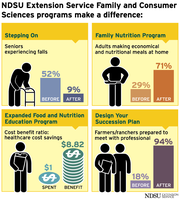NDSU Extension Family, Consumer Programs Targeted at Prevention
(Click the image below to view a high-resolution image that can be downloaded)
Health and wellness are among the biggest challenges facing North Dakota, as well as the rest of the nation.
The U.S. conducts cutting-edge biomedical research and has a sophisticated clinic system, yet Americans’ life expectancy is 42nd in the world, and U.S. infant mortality rates are the worst among the 27 wealthiest countries.
North Dakotans’ obesity rates doubled from 12 percent in 1990 to 25 percent in 2005 and rose to more than 27 percent in 2012 (the latest statistics available). More than one-third of North Dakotans have high cholesterol and 29 percent have high blood pressure. Also, more than 72 percent of North Dakotans do not eat fruits and vegetables at the levels health experts recommend, and nearly half don’t get enough physical activity.
The North Dakota State University Extension Service is working to reverse those trends with its family and consumer science (FCS) programs. Extension provides educational FCS programming in three areas - family economics, human development and family science, and nutrition, food safety and health - through Extension FCS agents in 32 counties across the state.
Statistics show Extension’s educational efforts such as the Family Nutrition Program (FNP) and Expanded Food and Nutrition Education Program (EFNEP) are making a difference. These programs help low-resource families and youth make healthful food choices, increase their physical activity, get the most nutritious food for the money they spend on groceries and become savvier about food safety.
Programs for youth, including Banking on Strong Bones, which increases dairy consumption, and On the Move to Better Health, and health and nutrition programs for older adults, such as Nourishing Boomers and Beyond, are having an impact as well. For example:
- After participating in FNP, 63 percent of adults adapted at least one habit to spend their food dollars more wisely, and among youth, 86 percent are eating more fruit and 56 percent are eating more vegetables.
- 83 percent of EFNEP participants improved at least one nutrition practice and 47 percent improved at least one food safety practice.
- Following the Banking on Strong Bones program, the number of youth who would choose soda pop instead of milk dropped from 36 to 25 percent.
- 62 percent of the On the Move to Better Health participants reported increasing their daily physical activity, 58 percent are choosing more healthful snacks and 54 percent are eating more fruit and vegetables.
“Establishing healthy eating habits at a young age is critical because changing poor eating habits in adulthood is difficult,” says Macine Lukach, NDSU Extension’s family and consumer science agent in Cavalier County.
Like many North Dakotan adults, Leslie Carlson of Rolette County is concerned about staying healthy, so she signed up for the Nourishing Boomers and Beyond program. It’s designed to help people 50 and older develop strategies to reduce their risk of developing chronic diseases, but any adult can benefit from the information.
“No matter how much a person has learned, you always can learn something new,” she says.
One way she is putting what she learned into practice is to include vegetables in the lunches she packs for her husband and his brother, who are farmers.
Other Extension programs that are helping North Dakotans improve their life include Design Your Succession Plan, which assists farm and ranch families in getting started on their succession planning and determining their vision for the farm or ranch, and Stepping On, a program that teachers seniors how to reduce the risk of falling. Stepping On is aimed at increasing the likelihood of seniors being able to stay in their homes and aging in place.
Donnybrook-area producer David Miller, who is hoping to retire this year, found Design Your Succession Plan was so helpful that he attended the program twice.
“It gave me a road map to do what I want to do,” he says. “It gets you to sit down and list your assets and go through your situation.”
Three months after completing the Stepping On program, 79 percent of the participants reported they found ways to reduce hazards that could cause them to fall at home, and 96 percent had practiced techniques for standing, walking, and climbing curbs and stairs safely.
Research shows FCS programs also have significant economic benefits. For instance, more healthful diets and a reduced risk of chronic diseases result in long-term health-care cost savings of $3.62 to $12.50 for every $1 spent on the EFNEP program. That is an estimated savings of $86 million to $185 million in the north-central region of the U.S.
Although the Extension Service is one of a number of agencies and organizations that work to address and prevent health-related, financial or environmental problems, Extension is not duplicating the others’ services, according to Deb Gebeke, NDSU’s assistant Extension director for family and consumer sciences.
“The NDSU Extension Service targets primary prevention education work,” she says. “Social services and health organizations target intervention work.”
Extension and the other agencies and organizations often collaborate on efforts, and Extension’s programming complements the others’ work.
“No one entity can resolve complex issues alone,” Gebeke says.
NDSU Agriculture Communication - Sept. 20, 2016
| Source: | Deb Gebeke, 701-231-9688, debra.gebeke@ndsu.edu |
|---|---|
| Editor: | Ellen Crawford, 701-231-5391, ellen.crawford@ndsu.edu |


